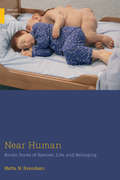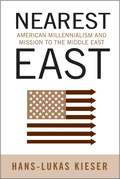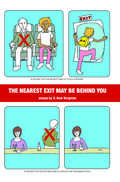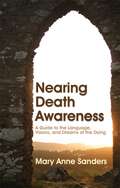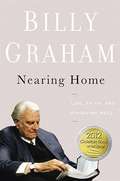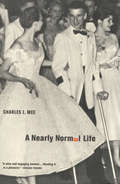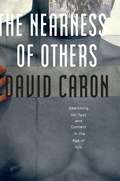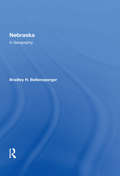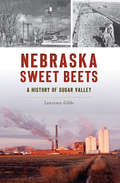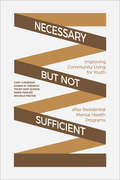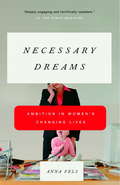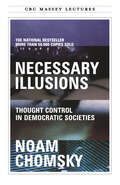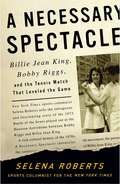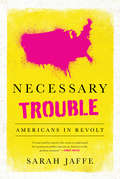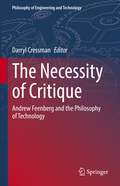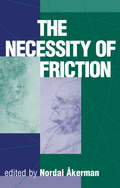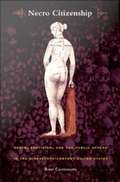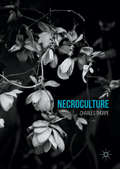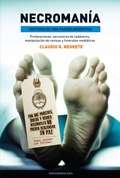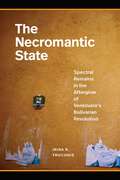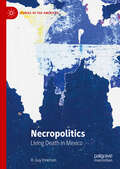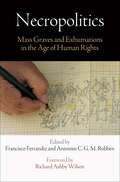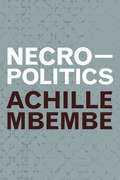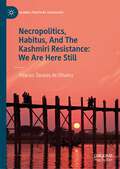- Table View
- List View
Near Human: Border Zones of Species, Life, and Belonging (Medical Anthropology)
by Mette N. SvendsenNear Human takes us into the borders of human and animal life. In the animal facility, fragile piglets substitute for humans who cannot be experimented on. In the neonatal intensive care unit, extremely premature infants prompt questions about whether they are too fragile to save or, if they survive, whether they will face a life of severe disability. Drawing on ethnographic fieldwork carried out on farms, in animal-based experimental science labs, and in hospitals, Mette N. Svendsen shows that practices of substitution redirect the question of "what it means" to be human to "what it takes" to be human. The near humanness of preterm infants and research piglets becomes an avenue to unravel how neonatal life is imagined, how societal belonging is evaluated, and how the Danish welfare state is forged. This courageous multi-sited and multi-species approach cracks open the complex ethical field of valuating life and making different kinds of pigs and different kinds of humans belong in Denmark.
Nearest East: American Millennialism and Mission to the Middle East
by Kieser Hans-LukasLong before oil interests shaped American interaction with the Middle East, the U. S. had a strong influence on the late Ottoman and post-Ottoman region. Covering the period from approximately 1800 to the 1970s, Hans-Lukas Kieser's compelling Nearest East tells the story of this intimate, identity-building relationship between the U. S. and the Near East. Kieser chronicles how American missionaries worked to implement their belief in Biblical millennialism, enlightened modernity, and a modern Zion-Israel. Millennialism was part of an American identity that constituted itself religiously in the interaction with and the representation of the "cradle of Zion. " As such, "going Near East" was-at least to American evangelical Protestants-in some ways more important than colonizing the American West. However, many Ottoman Muslims felt threatened by the American missionaries perceiving their successful institutions as an estranging challenge from the outside. Measuring the long twisted road from the missionary Zion-builders of the early 19th century to the privileged US-Israeli partnership in the late 20th century,Nearest East looks carefully on both sides of the relationship. Kieser uses a wide range of Ottoman, Turkish, French, German and other sources, unfamiliar to most Anglophone readers, to tell this story that will appeal to historians of all stripes.
The Nearest Exit May Be Behind You: Essays
by S. Bear BergmanAlternately unsettling and affirming, devastating and delicious, The Nearest Exit May Be Behind You is a new collection of essays on gender and identity by S. Bear Bergman that is irrevocably honest and endlessly illuminating. With humor and grace, these essays deal with issues from women's spaces to the old boys' network, from gay male bathhouses to lesbian potlucks, from being a child to preparing to have one. Throughout, S. Bear Bergman shows us there are things you learn when you're visibly different from those around you—whether it's being transgressively gendered or readably queer. As a transmasculine person, Bergman keeps readers breathless and rapt in the freakshow tent long after the midway has gone dark, when the good hooch gets passed around and the best stories get told. Ze offers unique perspectives on issues that challenge, complicate, and confound the "official stories" about how gender and sexuality work.
Nearing Death Awareness: A Guide to the Language, Visions, and Dreams of the Dying
by Mary Anne SandersDying is a complex experience for the dying person and their family, friends, and carers, that involves all aspects of what it means to be human: physical, mental, and spiritual. The author describes different types of Nearing Death Awareness (NDA), including visions, dreams, and symbolic language, and offers practical guidance for family and carers of the dying about how to respond appropriately and supportively to NDA behavior. This sensitive and informative book will make fascinating reading not only for anyone who is likely to accompany a dying person, but for anyone with an interest in spirituality.
Nearing Home: Life, Faith, and Finishing Well
by Billy GrahamBut I do not account my life of any value nor as precious to myself, if only I may finish my course and the ministry that I received from the Lord Jesus, to testify to the gospel of the grace of God. -Acts 20:24 (ESV). "Growing old has been the greatest surprise of my life," says Billy Graham, known by many as God's Ambassador. "I would have never guessed what God had in store for me, and I know that as I am nearing home, He will not forsake me the last mile of the way." In Nearing Home this man of faith--now in his nineties--explores the challenges of aging while gleaning foundational truths from Scripture. Billy Graham invites us to journey with him as he considers the golden years while anticipating the hope of being reunited with his wife, Ruth, in his heavenly home that eclipses this world. "When granted many years of life, growing old in age is natural, but growing old with grace is a choice," says the author. "Growing older with grace is possible for all who will set their hearts and minds on the Giver of grace, the Lord Jesus Christ." Join Billy Graham as he shares the challenges of fading strength but still standing strong in his commitment to finishing life well.
A Nearly Normal Life: A Memoir
by Charles L. MeeIn the summer of 1953 the author was a carefree, athletic boy of fourteen. But after he collapsed during a school dance one night, he was suddenly bedridden, drifting in & out of consciousness, as his body disintegrated into a shadow of its former self. He had been stricken with spinal polio. When he emerged from the grip of the disease, he was confronted with a life change so enormous that it challenged all he had believed in & forced him, despite his young age, to redefine himself. His once stereotypically normal life, filled with baseball & swimming pools & dreams of girls, had been irreversibly altered. He was almost the same person he had been; he was nearly normal. His moving personal narrative is a textured portrait of life in the fifties - a time when America & her fighting spirit collided with this disease. Both funny & profound, he is a gifted, unique writer, who unravels the mysteries of youth in a Cold War climate, who gives voice to the mind of a child with a potentially fatal disease, & whose recognition of himself as a disabled outsider heightens his brilliant talents as a storyteller.
The Nearness of Others: Searching for Tact and Contact in the Age of HIV
by David Caron&“Funny how a gay man&’s hand resting heavily on your shoulder used to say let&’s fuck but now means let&’s not. Funny how ostensible nearness really betrays distance sometimes.&” —from The Nearness of OthersIn this radical, genre-bending narrative, David Caron tells the story of his 2006 HIV diagnosis and its aftermath. On one level, The Nearness of Others is a personal account of his struggle as a gay, HIV-positive man with the constant issue of if, how, and when to disclose his status. But searching for various forms of contact eventually leads to a profound reassessment of tact as a way to live and a way to think, with our bodies and with the bodies of others.In a series of brief, compulsively readable sections that are by turns moving and witty, Caron recounts his wary yet curious exploration of an unfamiliar medical universe at once hostile and protective as he embarks on a new life of treatment without end. He describes what it is like to live with a disease that is no longer a death sentence but continues to terrify many people as if it were. In particular, living with HIV provides an unexpected opportunity to reflect on an age of terror and war, when fear and suspicion have become the order of the day. Most of all, Caron reminds us that disclosing HIV-positive status is still far from easy, least of all in one of the many states—such as his own—that have criminalized nondisclosure and/or exposure.Going well beyond Caron&’s personal experience, The Nearness of Others examines popular culture and politics as well as literary memoirs and film to ask deeper philosophical questions about our relationships with others. Ultimately, Caron eloquently demonstrates a form of disclosure, sharing, and contact that stands against the forces working to separate us.
Nebraska: A Geography
by Bradley H. BaltenspergerNebraska is the first comprehensive examination of the patterns of Nebraska’s resources, population, economy, climate, and landscape to be published in many years. Focusing especially on the people of Nebraska and the interaction between the environment and human use of the earth, Professor Baltensperger begins with a discussion of the physical environment and resources of the state and ties early patterns of development to the need to adjust settlement systems and agricultural practices to a subhumid climate. The role of energy-intensive agriculture in the state’s economy is a central aspect of the book’s examination of human interaction with the environment: The impact of modern technology on Nebraska’s agricultural system and on its population receives considerable attention, as do the problems associated with recent agricultural developments. Also scrutinized are the land-use conflicts generated by urban growth and by the demands of an urban society on rural Nebraska.
Nebraska Sweet Beets: A History of Sugar Valley
by Lawrence GibbsSugar beets are as tenaciously rooted in Nebraska's history as they are in its soil, especially in a seventy-mile stretch of the North Platte Valley that extended into eastern Wyoming. The state's first processing facility opened in Grand Island in 1890, boasting the largest mill in the world. The height of the beet boom occurred in the early part of the twentieth century as Wyobraskan towns courted factory locations as feverishly as rival sugar companies competed for territory, and an irrigation network turned the region into America's Valley of the Nile. Some rail lines have disappeared from the map, while catastrophes like the Scottsbluff and Bayard sugar bin explosions and the Gering Molasses spill will never be forgotten. From neglected beet dumps and abandoned rail spurs to silos ready for future harvests, explore Sugar Valley's heritage with Lawrence Gibbs.
Necessary but Not Sufficient: Improving Community Living for Youth after Residential Mental Health Programs
by Gary Cameron Karen M. Frensch Trudy Smit Quosai Mark Pancer Michele PreydeYouth residential mental health care is often a last resort after a long time searching for help. Despite engaging with residential care, moving from residential mental health programs to life in the community, many youth still confront disturbing prospects. Incorporating vignettes, chapter summaries, as well as theory and evidence in fields such as education, juvenile justice, child welfare, independent living, supporting families, and positive youth development, this book proposes a template that is both credible and feasible for improving community living outcomes for youth leaving residential mental health programs.
Necessary Dreams: Ambition in Women's Changing Lives
by Anna FelsIn this groundbreaking book about how women perceive, are prepared for, and cope with ambition and achievement, psychiatrist Anna Fels examines ambition at the deepest psychological level. Cutting to the core of what ambition can provide--the essential elements of a fulfilling life--Fels describes why, for women but not for men, ambition still remains fraught with often painful conflict. Fels draws on case studies, research, interviews, and autobiographies of accomplished and celebrated women past and present--writers, artists, architects, politicians, actors--to explore the ways in which women are brought up to avoid recognition and visibility in favor of traditional feminine values and why they often choose to nurture and defer to rather than compete with men. She poses invaluable questions: What is the nature of ambition and how important is it in a woman's life? What are the forces that promote or impede its development? To what extent does ambition go against a woman's very nature? And she challenges currently held theories about the state of mind and the needs of men. Incisive and highly readable, Necessary Dreams is a unique exploration of the options and obstacles women face in the pursuit of their goals. It is a book that every woman will want--and need--to read.
Necessary Illusions: Thought Control in Democratic Societies (The CBC Massey Lectures)
by Noam ChomskyIn his national bestselling 1988 CBC Massey Lectures, Noam Chomsky inquires into the nature of the media in a political system where the population cannot be disciplined by force and thus must be subjected to more subtle forms of ideological control. Specific cases are illustrated in detail, using the U.S. media primarily but also media in other societies. Chomsky considers how the media might be democratized (as part of the general problem of developing more democratic institutions) in order to offer citizens broader and more meaningful participation in social and political life.
A Necessary Spectacle: Billie Jean King, Bobby Riggs, and the Tennis Match That Leveled the Game
by Selena RobertsBillie Jean King didn't want to play Bobby Riggs. He baited and begged her for months while she ignored his catcalls and challenges.
Necessary Targets: A Story of Women and War
by Eve EnslerTHE STORY: In NECESSARY TARGETS, two American women, a Park Avenue psychiatrist and an ambitious young writer, travel to Bosnia to help women refugees confront their memories of war. Though the two have little in common beyond the methods they use to distance themselves from their subjects, they emerge deeply changed as they confront their own fears in the face of violence, resiliency and war. Based on interviews conducted by Eve Ensler with numerous women who survived the civil war in the former Yugoslavia, NECESSARY TARGETS is a timely reminder of how America struggles to define its relationship to the rest of the world.
Necessary Trouble: Americans in Revolt
by Sarah JaffeNecessary Trouble is the definitive book on the movements that are poised to permanently remake American politics. We are witnessing a moment of unprecedented political turmoil and social activism. Over the last few years, we've seen the growth of the Tea Party, a twenty-first-century black freedom struggle with BlackLivesMatter, Occupy Wall Street, and the grassroots networks supporting presidential candidates in defiance of the traditional party elites.Sarah Jaffe leads readers into the heart of these movements, explaining what has made ordinary Americans become activists. As Jaffe argues, the financial crisis in 2008 was the spark, the moment that crystallized that something was wrong. For years, Jaffe crisscrossed the country, asking people what they were angry about, and what they were doing to take power back. She attended a people's assembly in a church gymnasium in Ferguson, Missouri; walked a picket line at an Atlanta Burger King; rode a bus from New York to Ohio with student organizers; and went door-to-door in Queens days after Hurricane Sandy.From the successful fight for a 15 minimum wage in Seattle and New York to the halting of Shell's Arctic drilling program, Americans are discovering the effectiveness of making good, necessary trouble. Regardless of political alignment, they are boldly challenging who wields power in this country.
The Necessity of Critique: Andrew Feenberg and the Philosophy of Technology (Philosophy of Engineering and Technology #41)
by Darryl CressmanThe essays in this edited collection are inspired by Andrew Feenberg’s philosophy of technology. Feenberg is the leading critical theorist of technology working today, combining the critical traditions of Karl Marx, Martin Heidegger, Georg Lukáacs, and Herbert Marcuse with empirical methods from science & technology studies (STS) and media studies.Divided into three parts, these contributions from philosophers, media theorists, design theorists, and STS scholars, reflect the relevancy of Feenberg's philosophy for making sense of our technically mediated society. This collection appeals to students and researchers interested in the philosophy of technology, critical theory, smart cities, big data, AI, and algorithmic culture.
The Necessity Of Friction
by Nordal AkermanFriction is what keeps us from realizing our goals. It is what compromises all of our plans, sometimes making them unrecognizable. It defies our wish for perfection and constantly surprises us with new elements of resistance. It constitutes the divide between dream and reality.But friction is also what gets us moving, a necessary incentive to achieve progress. Nothing can start if it cannot push off something else. By blocking or delaying the easy solution, friction makes for a richer, more varied world. If it stops schemes from being completely fulfilled, it also stops them form going totally awry.To the modernist project, with its one-sided rationalist pretensions, friction is unambiguously bad?and so it is being disposed of at an increasing speed. The currency markets are one example, cyberspace another. This means less and less time to pause and rethink, while the vulnerability of societies is aggravated. In The Necessity of Friction, scholars tackle this topical and important concept. A number of scientific fields are engaged: physics, philosophy, economics, architecture, organizational theory, artificial intelligence, and others. Together, these contributions form the first modern-day attempt at analyzing the intriguing yet elusive subject of friction as metaphor.
Necro Citizenship: Death, Eroticism, and the Public Sphere in the Nineteenth-century United States
by Russ CastronovoIn Necro Citizenship Russ Castronovo argues that the meaning of citizenship in the United States during the nineteenth century was bound to--and even dependent on--death. Deploying an impressive range of literary and cultural texts, Castronovo interrogates an American public sphere that fetishized death as a crucial point of political identification. This morbid politics idealized disembodiment over embodiment, spiritual conditions over material ones, amnesia over history, and passivity over engagement. Moving from medical engravings, séances, and clairvoyant communication to Supreme Court decisions, popular literature, and physiological tracts, Necro Citizenship explores how rituals of inclusion and belonging have generated alienation and dispossession. Castronovo contends that citizenship does violence to bodies, especially those of blacks, women, and workers. "Necro ideology," he argues, supplied citizens with the means to think about slavery, economic powerlessness, or social injustice as eternal questions, beyond the scope of politics or critique. By obsessing on sleepwalkers, drowned women, and other corpses, necro ideology fostered a collective demand for an abstract even antidemocratic sense of freedom. Examining issues involving the occult, white sexuality, ghosts, and suicide in conjunction with readings of Harriet Jacobs, Ralph Waldo Emerson, Frederick Douglass, Nathaniel Hawthorne, and Frances Harper, Necro Citizenship successfully demonstrates why Patrick Henry's "give me liberty or give me death" has resonated so strongly in the American imagination.
Necroculture
by Charles ThorpeIn this book, the author draws on Karl Marx's writings on alienation and Erich Fromm's conception of necrophilia in order to understand these aspects of contemporary culture as expressions of the domination of the living by the dead under capitalism. Necroculture is the ideological reflection and material manifestation of this basic feature of capitalism: the rule of dead capital over living labor. The author argues that necroculture represents the subsumption of the world by vampire capital.
Necromanía: Historia de una pasión argentina. Profanaciones, secuestros de cadáveres, manipu
by Claudio R. NegreteLa historia argentina y las noticias diarias demuestran que existe unacultura muy arraigada con relación a la muerte y en particular a losmuertos. Este libro reúne los casos, las pruebas y las historias másasombrosas; desmonta rumores y releva testimonios para armar esterompecabezas tan apasionante como tenebroso. Todavía hoy persiste la obsesión por remover las cenizas de lospróceres, robar partes de cadáveres, festejar las fechas de losfallecimientos y convertirlas en feriados turísticos. El «marketingpolítico» abreva en esta mórbida costumbre para legitimar poder yprestigio. Bajo distintas formas fueron víctimas de la necromaníaargentina San Martín, Belgrano, Gardel, Lavalle, Gilda, Alberdi, JoséLuis Cabezas, Yrigoyen, Mercedes Sosa, Alfonsín, Evita, Perón, Monzón,Lola Mora, el Potro Rodrigo, Facundo Quiroga, María Marta GarcíaBelsunce, Rosas, Olmedo, Calfucurá, Leguizamo, Sarmiento, el PeritoMoreno, Vito Dumas, Rucci, el padre Mugica, Pappo, Azucena Villaflor,Fernando Peña, Jorge Guinzburg, Sandro y los desaparecidos.
The Necromantic State: Spectral Remains in the Afterglow of Venezuela's Bolivarian Revolution
by Irina R TroconisIn the spring of 2013, televisions across Venezuela announced the death of then-president Hugo Chávez, leader of the Bolivarian Revolution and key political actor in Latin America’s “turn to the left.” Chávez’s death, however, was not the end of Chávez’s life. In The Necromantic State, Irina R. Troconis examines how Chávez, as a “specter,” has lingered in Venezuela’s public, private, and digital spaces. Focusing on contemporary Venezuela and drawing from a diverse corpus that includes tattoos, toys, memes, graffiti, and a hologram haunting the streets of downtown Caracas, Troconis contends that, in moments of failed transitions, political tensions, and crises of legitimacy, the state brings the dead back to life to negotiate the terms of its survival. By showing how this necromantic performance enables the state’s material and visual manifestations in public and private spaces, Troconis untangles a sociopolitical moment in which the ghostly acts as the affective, social, and political force that grounds state authority and ensures the preservation of the status quo, as it circumscribes acts of political imagination and limits popular resistance.
Necropolitics: Living Death in Mexico (Studies of the Americas)
by R. Guy EmersonThis book offers a contemporary look at violence in Mexico and argues for a recalibration in how necropolitics, as the administration of life and death, is understood. The author locates the forces of mortality directly on the body, rather than as an object of government, thereby placing death in a politics of the everyday. This necropolitics is explored through testimonies of individuals living in towns overrun by organized crime and resistance groups, namely, the autodefensa movement, that operate throughout Michoacán, one of the most violent states in Mexico. This volume studies how individuals and communities go on living not in spite of the death that surrounds life, but more disturbingly by attuning to it.
Necropolitics: Mass Graves and Exhumations in the Age of Human Rights (Pennsylvania Studies in Human Rights)
by Francisco Ferrándiz Antonius C. Robben Richard Ashby WilsonThe unmarked mass graves left by war and acts of terror are lasting traces of violence in communities traumatized by fear, conflict, and unfinished mourning. Like silent testimonies to the wounds of history, these graves continue to inflict harm on communities and families that wish to bury or memorialize their lost kin. Changing political circumstances can reveal the location of mass graves or facilitate their exhumation, but the challenge of identifying and recovering the dead is only the beginning of a complex process that brings the rights and wishes of a bereaved society onto a transnational stage.Necropolitics: Mass Graves and Exhumations in the Age of Human Rights examines the political and social implications of this sensitive undertaking in specific local and national contexts. International forensic methods, local-level claims, national political developments, and transnational human rights discourse converge in detailed case studies from the United States, Argentina, Chile, Peru, Spain, Bosnia-Herzegovina, Greece, Rwanda, Cambodia, and Korea. Contributors analyze the role of exhumations in transitional justice from the steps of interviewing eyewitnesses and survivors to the painstaking forensic recovery and comparison of DNA profiles. This innovative volume demonstrates that contemporary exhumations are as much a source of personal, historical, and criminal evidence as instruments of redress for victims through legal accountability and memory politics.Contributors: Zoë Crossland, Francisco Ferrándiz, Luis Fondebrider, Iosif Kovras, Heonik Kwon, Isaias Rojas-Perez, Antonius C. G. M. Robben, Elena Lesley, Katerina Stefatos, Francesc Torres, Sarah Wagner, Richard Ashby Wilson.
Necropolitics (Theory in Forms)
by Achille MbembeIn Necropolitics Achille Mbembe, a leader in the new wave of francophone critical theory, theorizes the genealogy of the contemporary world, a world plagued by ever-increasing inequality, militarization, enmity, and terror as well as by a resurgence of racist, fascist, and nationalist forces determined to exclude and kill. He outlines how democracy has begun to embrace its dark side---what he calls its &“nocturnal body&”---which is based on the desires, fears, affects, relations, and violence that drove colonialism. This shift has hollowed out democracy, thereby eroding the very values, rights, and freedoms liberal democracy routinely celebrates. As a result, war has become the sacrament of our times in a conception of sovereignty that operates by annihilating all those considered enemies of the state. Despite his dire diagnosis, Mbembe draws on post-Foucauldian debates on biopolitics, war, and race as well as Fanon's notion of care as a shared vulnerability to explore how new conceptions of the human that transcend humanism might come to pass. These new conceptions would allow us to encounter the Other not as a thing to exclude but as a person with whom to build a more just world.
Necropolitics, Habitus, And The Kashmiri Resistance: We Are Here Still (Global Political Sociology)
by Vinícius Tavares de OliveiraThis book engages the concept of necropolitics to present a vision of how to understand the physical body as a space of power and resistance to social order, in the context of the Kashmir resistance. The author sheds new light on the relations between India and Pakistan, with a focus on tensions over the Kashmir region, in order to better understand the emergence and stabilization of the narrative that criminalizes and thus justifies the population that rebels against state actions in the region. The research draws from archival and interview research and presents the reader with new insight into both conceptual and material dimensions of necropolitics.
